 |
 |
| [ Goal ] |
 |
|
The goal of our program is to make our Department of Brain Science and Engineering into the one and only center of research and education in the world, establishing the bases of brain-inspired technology as a new academic field. Towards that end, human resources are essential, with broad knowledge from the brain physiology, functions, to mechanisms and algorithms of information processing, and skills to develop a brain-like computers and hardware, and of their implementation and application.
We therefore instituted “Multi-Disciplinary COE-student Program (Multi-Talent Elite Education),” in which students pursue coursework and receive intensive training in four of their choosing in the five key fields depicted in Figure 2, “Physiology,” “Psychology,” “Theory and Models,” “Devices,” and “Robotics,” as part of the first two-year study of their masters’ level in the five-year postgraduate program. This multi-disciplinary training enables students to come up with bold research themes, to augment their coverage, and to broaden their perspectives.
|
 |
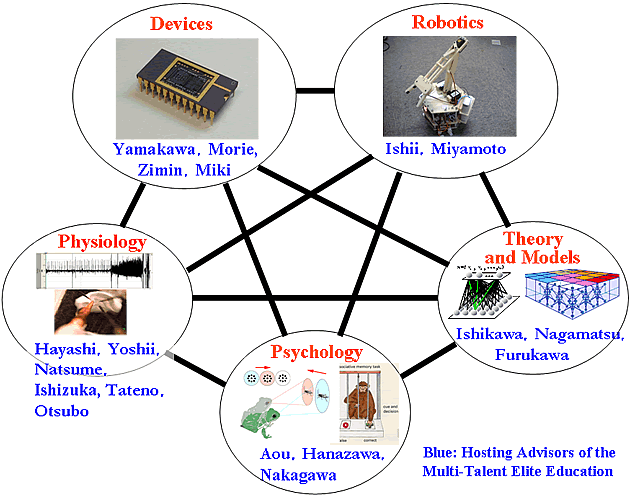 |
| Figure 2 Organization chart of the Multi-Disciplinary COE-student Program |
 |
| Page top ↑ |
 |
| [ Course ] |
 |
Students are admitted to a laboratory of their own choosing as their major specialty, which we call “Homeground Laboratory” in which they receive their instructions and training from “Homeground Supervisor.” Students also study in non-major laboratories, which we call “Hosting Laboratories” in which they pursue their basic coursework other than their major fields in these laboratories under “Hosting Advisors.”
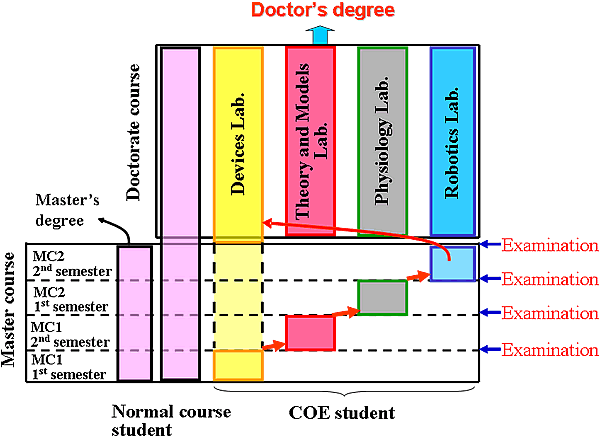 |
| Figure 3 Coursework schedule of the Multi-Disciplinary COE-student Program |
|
 |
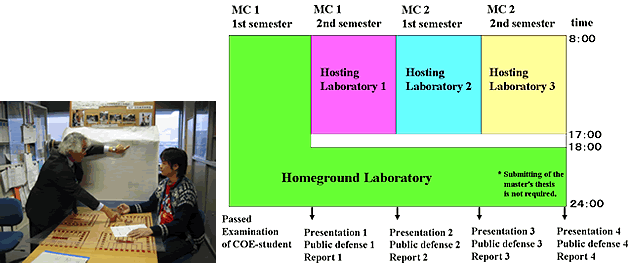 |
| Figure 4 “Multi-Talent Elite Education” is the one-on-one session, through which students receive private tutoring by the hosting adviser |
Figure 5 Typical daily life of the COE-student |
|
 |
|
In “Multi-Talent Elite Education,” students pursue coursework and receive intensive training in four different fields out of the five key fields in six months each in the first two-year study of their masters’ level, and they are required to produce a research report for each, subject to public defense. To be more concrete, as depicted in Figure 3, students will work intensively in the laboratory of their own choosing as their major specialty for the first six months, and only those who passed the public defense are granted to visit another laboratory of their choice for the next six months to receive their instructions and training there. After passing each public defense in six-month periods, students are eligible to move on to visit another laboratory to complete the course. As those who completed the course had written research reports in four different fields in two years, they will be conferred a master’s degree without filing an otherwise required master’s thesis. After that, students will move on to the doctorate course to engage in their primary research of interest.
One of the most notable characteristics in “Multi-Talent Elite Education” is the one-on-one session, through which students receive private tutoring by the hosting adviser, and after the six months, the knowledge and skills that students acquired in a different field are remarkable. (Figure 4).
|
 |
| Page top ↑ |
 |
| [ Financial Support ] |
 |
|
The COE students have no time to take up any part-time jobs, as they will be studying in double shift at the master’s level and they will be engaged in research around the clock from morning to mid-night in the doctorate program. As a support, we provide a financial aide of 80,000 yen (approx. US$800) a month for the students at the master’s level and of 100,000 yen (approx. US$1,000) a month for the students in the doctorate program, in order for students to sustain their living and to devote themselves to their academic activities without financial anxiety.
|
 |
| Page top ↑ |
 |
| [ Evaluation ] |
 |
The first semester at the master’s level
Daily activities, research reports, and public defenses are comprehensively evaluated, and only the top five candidates can continue to pursue “Multi-Talent Elite Education” as COE students. Other remaining candidates may continue without financial support, or fall back on to the normal course of study for thesis research. Even in the latter case, the financial support the students had received thus far need not be reimbursed.
The second semester and on
After each semester of visiting a laboratory, the students write a research report and are subjected to a public defense. After the defense, the students receive their grades of A, B, C, or F(ail). The A or B grade enables the student to move on to visit another laboratory. Two C’s will not be a serious problem, but three C’s will result in revocation of the COE studentship, just as a single F does. The revocation of the COE studentship does not entail the reimbursement of financial support the students had received thus far.
Even if the COE studentship is revoked, one can pursue his/her thesis research as a regular student in his/her initial homeground laboratory. In such a case, the student needs to complete the normal course of study and file his/her master’s thesis in order to obtain master’s degree. After that, the student can continue the doctorate course when admitted by passing the entrance exam and interviews.
When the students complete the “Multi-Talent Elite Education” in four different laboratories, passing four defenses, they will be conferred a master’s degree without filing their master’s theses.
|
 |
| Page top ↑ |
 |
| [ The List of Research Topics ] |
 |
| Physiology |
| (1) |
Neuronal modeling and analysis of neuro-dynamics (Professor Hayashi)
|
| (2) |
Electrophysiological characteristics and their equivalent circuitry of neural membrane (Professor Yoshii)
|
| (3) |
Measurement of neuronal rhythms generated in hippocampal slices in brain, and of brain waves of humans (Professor Natsume)
|
| (4) |
Techniques for electrophysiological measurement of brain slice specimen (Associate Professor Ishizuka)
|
| (5) |
Simulations of the single neuron model and the neural network model (Associate Professor Tateno)
|
 |
| Psychology |
| (6) |
Understanding of the central nervous strategies for individual survival and species preservation and neural ethology and neurophysiological measurement of in vivo specimen (a whole living animal) (Professor Aou)
|
| (7) |
Practicum for psychophysics and neuropsysiology of the visual system (Associate Professor Hanazawa)
|
| (8) |
Image-based quantitative analysis of collision avoidance behavior by anura (frogs), elucidation of emergent behavior mechanism, and practicum for experimental biology for modeling (Associate Professor Nakagawa)
|
 |
| Theory and Models |
| (9) |
Learning and self-organization of neural network (Professor Ishikawa)
|
| (10) |
Solutions for optimization problems and constraint-satisfaction problems (Professor Nagamatsu)
|
| (11) |
Theory and programming of neural network and self-organizing map (Professor Furukawa)
|
 |
| Devices |
| (12) |
Basics of semi-conductor process and design, prototyping, and pellet-checking of ICs (Professor Yamakawa)
|
| (13) |
Basics and design of CMOS digital-analog ICs and measurement of LSI (Professor Morie)
|
| (14) |
Physical techniques for robotics and neurophysiological experiments (Professor Zimin)
|
| (15) |
Practical techniques for system design with reconfigurable LSI and its implementation (Associate Professor Miki)
|
 |
| Robotics |
| (16) |
Techniques for robot design, motion analysis, and prototyping (Associate Professor Ishii)
|
| (17) |
Basics and application of motion-trajectory planning model and numerical modeling (Associate Professor Miyamoto)
|
|
 |
| Page top ↑ |
 |
| [ Track Record ] |
 |
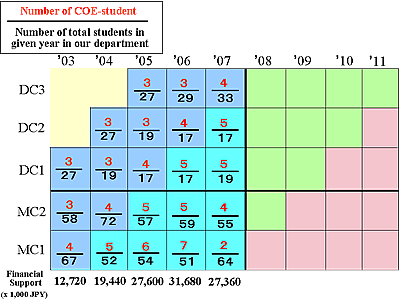 |
| Figure 6 The number of COE students who have completed the “Multi-Talent Elite Education |
 |
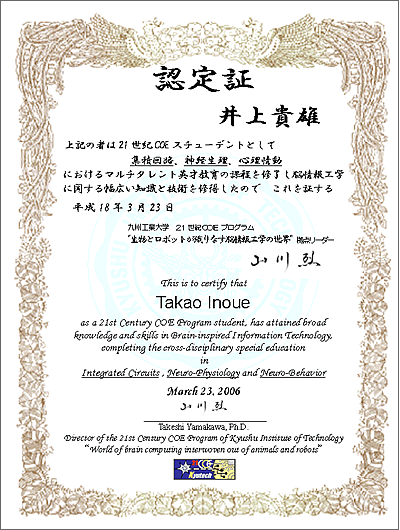 |
| Figure 7 Special certificate of completion of the COE-student program |
The Table 6 shows the number of COE students who have completed the “Multi-Talent Elite Education.” As our 21st Century COE Program started in 2003, the first recruitment was only for the first year students in the doctorate program, who were at the beginning stage for their dissertation research, and for students in the master’s program who were planning to go on to the doctorate program. After rigorous selection, four first-year doctorate students and three mater’s students each in the first and second year were awarded the COE studentship. In the following years, the same rigorous selections have been administered and a number of COE students have been thriving every year, which is shown in Table 6. The fraction in each cell in Table 6 indicates the number of total students in the given year in our department as the denominator and the number of COE students as the numerator. Those who have successfully completed the given coursework of the “Multi-Talent Elite Education” and have been conferred the doctorate degree also receive on their commencement a special certificate of completion with distinction, shown in Figure 7.
|
|
|